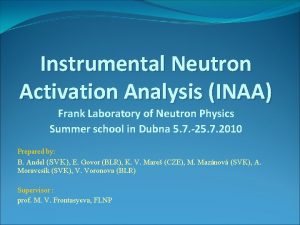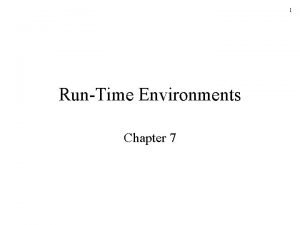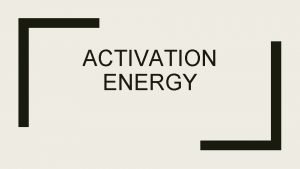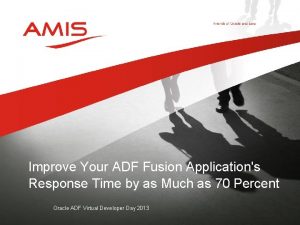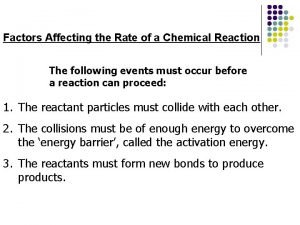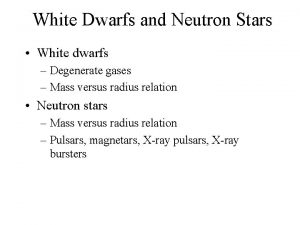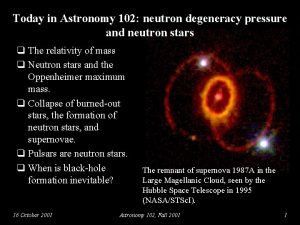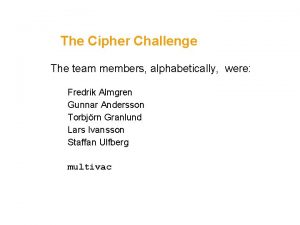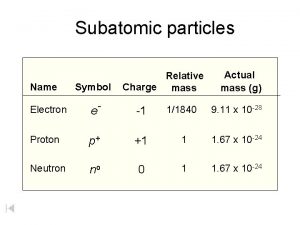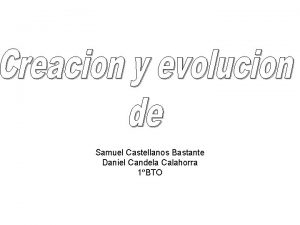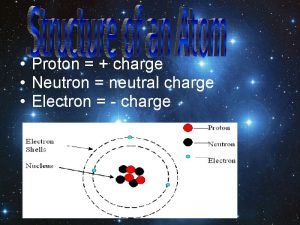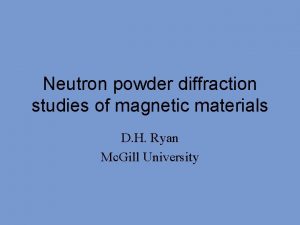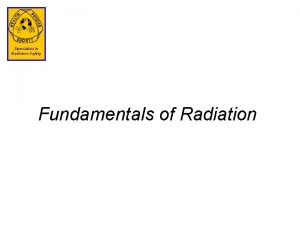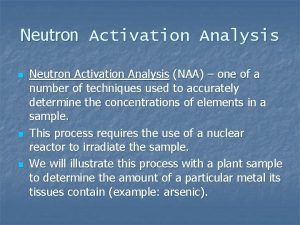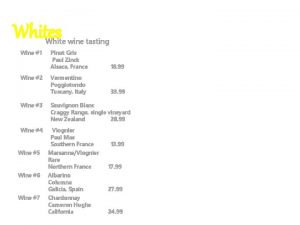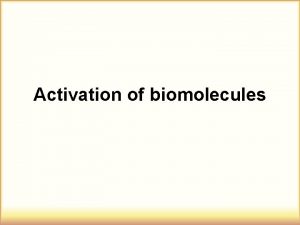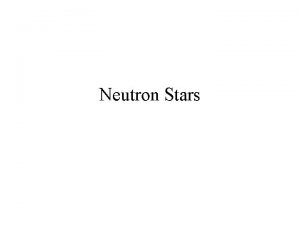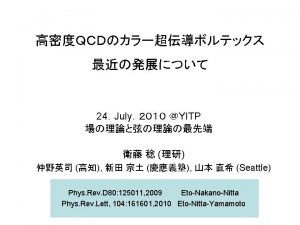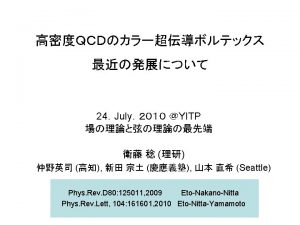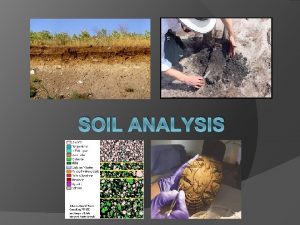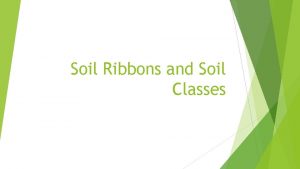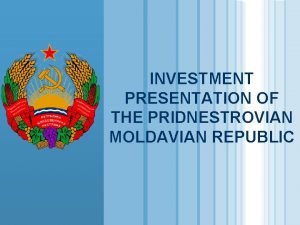Moldavian wine and soil analysis using neutron activation


















- Slides: 18

Moldavian wine and soil analysis using neutron activation analysis INGA ZINICOVSCAIA 1 Frank 2 Horia Laboratory of Neutron Physics, JINR, 6 Joliot-Curie Str. , 1419890, Dubna, Russia, zinikovskaia@mail. ru Hulubei National Institute for R&D in Physics and Nuclear Engineering, 30 Reactorului Str. MG-6, Bucharest - Magurele, Romania 3 Institute of Chemistry of the Academy of Science of Moldova, 3, Academiei Str. , 2028 Chisinau, R. Moldova

Wine is a beverage of great social and economic significance widely consumed around the world. The Republic of Moldova is a wellknown producer of world-class wines, which play a critical role in the economy of the country. vineyard area - 148, 500 hectares, of which 107, 800 hectares are used for commercial production 2

Wines typically contain: Ø major elements such as Na, Mg, K, and Ca, whose concentration is greater than 10 mg/l; Ø trace elements such as Al, Mn, Fe, and Zn, whose concentration overpass 10 μg/l; Ø and ultra-trace elements such as Cr, Ni, As, or Cd, whose concentration is lower than micrograms per liter. 3

Why its important to determine the elemental content of wine? to asses the effect of soil on wine composition to asses the effect of anthropogenic activity on wine composition to test the wine provenance or region of origin 4

ICP-AES ICP-MS AAS Wine analysis IR spectrometry XRF NAA 5

Cabarnet, Regent, Pinot Noir, Nero, Syzar, Merlot, Malbec, Sauvignon, Riesling, Pinot Gris, Muscat, Uni. Blanc Pinot, Chardonnay, Cabernet, Chardonney, Pinot Frank 6

Cricova

Romanesti

REGATA 9

Elemental analysis of soil The bi-plot illustrating the homogeneity of the soil samples as resulted from the Principal Component Analysis (UCC and AS stay for Upper Continental Crust and Average Soil respectively) 10

Rb/Sr ratio 1. 11 is significantly higher than UCC one of 0. 26 (Rudnick and Gao, 2004), AS of 0. 33 (Vinogradov, 1959 cited by Shacklette and Boerngen, 1984), indicating a significant chemical weathering The Sc-La-Th discriminating ternary diagram proving a primary continental origin of the soil material 11

Average numerical values (± St. Dev. ) of the content of Cr, Mn, Co, Ni, Zn and As together with the corresponding limits defined by the Moldavian, Romanian and Russian authorities. Element Cr Mn Co Ni Zn As Soil content 91 ± 9 678 ± 56 13 ± 1 35 ± 7 72 ± 10 8. 7 ± 1. 1 Moldova ---75 300 -- Russian Federation ---20 - 80 55 - 220 2 - 10 Romania 30 - 100 900 - 1500 15 - 30 20 - 75 100 - 300 5 - 12. 5 Average numerical values (± St. Dev. ) of the Enrichment Factor (EF), Geoaccumulation Index (Igeo), as well as of the Pollution Index of the investigated soils Element EF ± St. Dev Igeo ± St. Dev Cr 1. 29 ± 0. 12 -0. 62 ± 0. 15 Mn 1. 18 ± 0. 13 - 0. 75 ± 0. 12 Co 1. 01 ± 0. 06 - 0. 97 ± 0. 13 Ni 0. 84 ± 0. 10 - 1. 24 ± 0. 24 Zn 1. 33 ± 0. 14 -0. 58 ± 0. 22 As 7. 14 ± 0. 47 1. 85 ± 0. 16 Pollution Index ± St. Dev 1. 15 ± 0. 11 12

The experimental values (± s) of the concentrations of 18 elements in investigated wines determined by NAA, All concentrations expressed in mg/l excepting Co, Ni, As, Br, Sb, Cs, Ba and U whose concentrations are expressed in µg/l. Element Na Mg Al K Ca Mn Fe Co Ni Zn As Br Rb Sr Sb Cs Ba U Romanesti red 19 ± 9 104 ± 12 1. 4 ± 1. 0 690 ± 80 54 ± 14 1. 35 ± 0. 14 3. 5 ± 3. 3 6. 3 ± 3. 6 39 ± 10 0. 44 ± 0. 23 - 280 ± 90 1. 7 ± 0. 2 1. 01 ± 0. 23 0. 48 ± 0. 18 3. 3 ± 0. 8 276 ± 270 0. 12 ± 0. 06 Romanesti white 16 ± 1 87 ± 12 1. 9 ± 0. 5 380 ± 230 75 ± 24 1. 22 ± 0. 25 2 ± 1. 9 9. 8 ± 1. 4 32 ± 11 0. 55 ± 0. 04 - 92 ± 92 1. 1 ± 0. 5 0. 64 ± 0. 19 0. 41 ± 0. 13 3. 1 ± 2. 5 110 ± 30 0. 20 ± 0. 06 Cricova red 11 ± 77 ± 1. 4 ± 550 ± 66 ± 0. 93 ± 1. 1 ± 4. 2 ± 18 ± 0. 92 ± 0. 26 ± 69 ± 1. 6 ± 0. 84 ± 0. 59 ± 7. 5 ± 70 ± 0. 13 ± 2 5 1. 0 80 13 0. 14 0. 7 1. 6 9 0. 41 0. 21 25 0. 32 0. 37 2. 8 41 0. 04 Cricova white 11 ± 92 ± 1. 5 ± 460 ± 68 ± 1 ± 0. 7 ± 3. 2 ± 20 ± 0. 49 ± 0. 3 ± 104 ± 1. 6 ± 0. 75 ± 0. 53 ± 6. 1 ± 87 ± 0. 13 ± 3 21 0. 7 100 21 0. 2 0. 4 0. 7 5 0. 08 0. 12 44 10. 3 0. 15 0. 26 1. 1 27 0. 01 13

Literature data for wines with different origin Element Lopez. Cvetkovici et Artiguez et al (2002) al (1996) Lara et al (2005) Fiket et al (2011) Geana et al (2013) red Na Mg Al K Ca Mn Fe Co Ni 27 -54 79 -109 1. 0 -4. 1 435 -652 85 -150 0. 1 -51 2. 2 -4. 9 Alkis 2014 white 8. 6 - 9. 2 18 17. 0 - 18. 0 730 - 940 13 - 78 Boscheti 2013 04 - 1. 2 11 - 14 0. 51 - 1. 21 0. 06 - 1. 00 2. 9 - 6. 7 2. 8 - 6. 0 0. 3 - 6. 0 5 - 217 0. 18 - 1. 44 1. 3 - 42. 0 1 - 322 0. 11 - 0. 70 0. 7 - 1. 7 0. 5 - 6. 3 134 - 573 Zn 0. 07 - 1. 56 0. 09 - 0. 11 0. 33 - 0. 69 0. 06 - 1. 00 0. 18 - 1. 44 0. 39 - 2. 10 As 1. 13 - 5. 13 51 - 140 0. 9 - 2. 7 Br Rb Sr Sb 3. 4 - 7. 1 2. 8 - 6. 5 0. 6 - 0. 7 1. 64 - 6. 02 0. 69 - 9. 66 0. 1 - 2. 01 0. 35 - 1. 54 0. 2 - 1. 8 0. 14 - 1. 60 3. 7 - 6. 6 0. 24 - 2. 10 0. 25 - 1. 09 Cs 0. 1 - 9. 5 Ba U 62 - 116 28 - 154 0. 17 - 1. 01 14

The discriminating Root 2 vs. Root 1 bi-plot illustrating the result of Discriminate Analysis of the 24 sets of wines. It can be remarked that the Romanesti wines are better discriminated with respect to Cricova ones. 15

The numerical values ± combined uncertainty of the transfer factors expressed in mg/l for all investigated wines Element Romanesti – red wine Romanesti – white wine Cricova – red wine Cricova – white wine Na 4. 5 ± 2. 2 3. 9 ± 0. 3 2. 7 ± 0. 6 2. 7 ± 0. 8 Mg 5. 3 ± 1. 0 4. 6 ± 0. 9 3. 6 ± 0. 6 4. 3 ± 1. 2 Al 0. 02 ± 0. 02 0. 03 ± 0. 01 K 36 ± 5 21 ± 14 27 ± 5 32 ± 6 Ca 5 ± 2 6 ± 4 7 ± 2 7 ± 3 Mn 2. 0 ± 0. 3 1. 8 ± 0. 4 1. 3 ± 0. 2 1. 4 ± 0. 3 Fe 0. 1 ± 0. 1 0. 04 ± 0. 03 ± 0. 02 Co 0. 5 ± 0. 3 0. 8 ± 0. 1 0. 4 ± 0. 1 0. 3 ± 0. 1 Ni 1. 2 ± 0. 3 0. 9 ± 0. 3 0. 5 ± 0. 3 0. 6 ± 0. 1 Zn 6 ± 3 8 ± 1 16 ± 7 8 ± 1 As - - - 0. 03 ± 0. 02 0. 03 ± 0. 01 Br 35 ± 12 13 ± 14 8 ± 3 12 ± 5 Rb 16 ± 2. 0 11 ± 5 17 ± 3 Sr 12 ± 4 7 ± 3 6 ± 2 Sb 0. 5 ± 0. 2 0. 7 ± 0. 5 0. 7 ± 0. 3 Cs 0. 6 ± 0. 2 0. 6 ± 0. 5 1. 7 ± 0. 6 1. 4 ± 0. 3 Ba 0. 7 ± 0. 7 0. 3 ± 0. 1 0. 2 ± 0. 1 U 0. 05 ± 0. 03 0. 10 ± 0. 03 0. 05 ± 0. 02 0. 05 ± 0. 01 16

Conclusion ENAA was used to determine the content of 35 major as well as trace elements in soils and 18 in wines from two renowned vineyards from the Republic of Moldova: Romanesti and Cricova. The soil of both vineyards is identical and close to the average composition of the UCC. A more detailed analysis of the distribution of Rb and Sr evidenced a significant degree of chemical weathering as well as a prolonged process of sorting and recycling of the mineral. The soil content of Cr, Mn, Co, Zn and As, the possible anthropogenic contaminates proved, with the exception of As, the absence of any systematic heavy element pollution. The ENAA data allowed calculating, for each sample of wine, the corresponding transfer factor which expresses at which extent a considered element is transported from vineyard plant to wine. Discriminant analysis allowed to classify wine samples in four distinct categories according to sort, red and white, and vineyard 17

Thank you for attention!
 Neutron activation analysis
Neutron activation analysis Neutron activation analysis
Neutron activation analysis Activation tree example
Activation tree example Living soil vs dead soil
Living soil vs dead soil Convergent plate boundaries
Convergent plate boundaries Isis neutron and muon source
Isis neutron and muon source Determine activation energy from graph
Determine activation energy from graph Activation and passivation in adf
Activation and passivation in adf The lower the activation energy the faster the reaction
The lower the activation energy the faster the reaction Neutron degeneracy pressure
Neutron degeneracy pressure Neutron degeneracy pressure definition
Neutron degeneracy pressure definition Cipher neutron
Cipher neutron Proton symbol relative charge and location
Proton symbol relative charge and location Candela y neutron
Candela y neutron Proton charge
Proton charge How are neutrons formed
How are neutrons formed Magnets for neutron diffraction
Magnets for neutron diffraction Chlorine number of protons and neutrons
Chlorine number of protons and neutrons Beta decay
Beta decay

